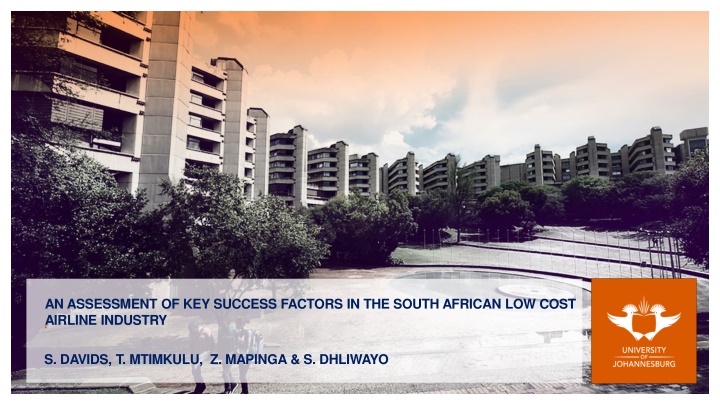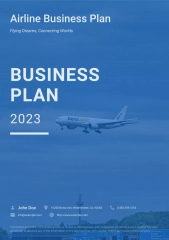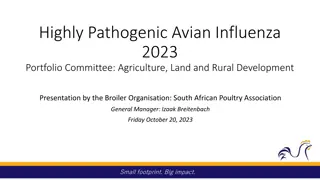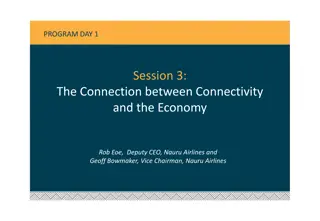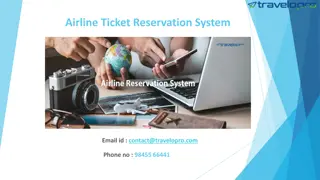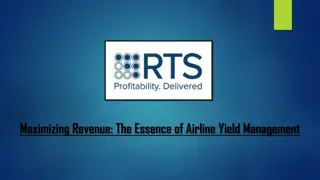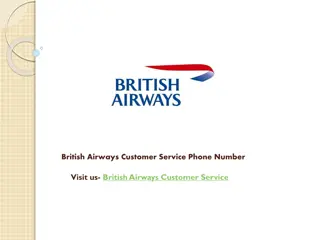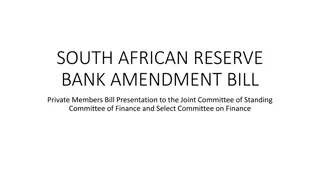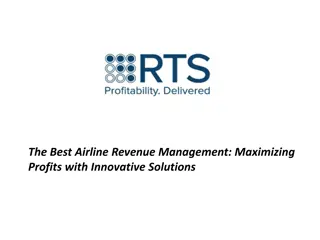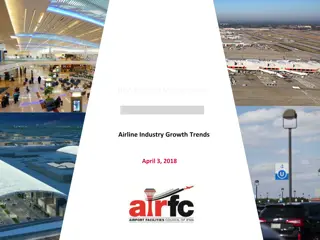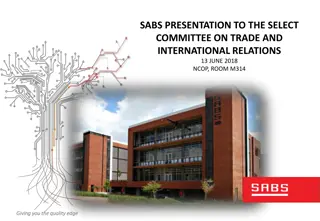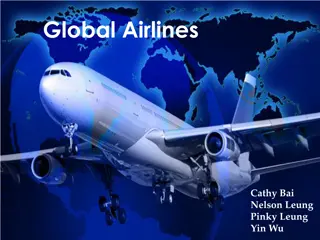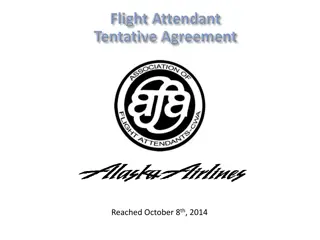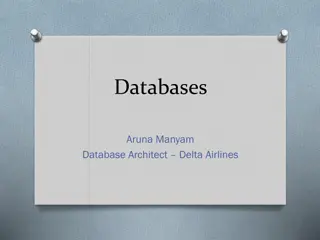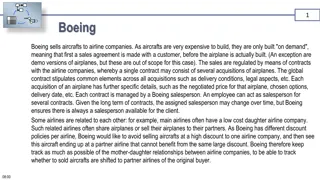Key Success Factors in South African Low Cost Airline Industry
This study assesses the key success factors influencing low-cost airlines in South Africa post-deregulation, exploring factors such as service quality, fleet management, turnaround time, and more. The research delves into the challenges faced by airlines in maintaining market share and surviving over extended periods. Findings from industry expert interviews provide insights into strategies for sustainable success within the competitive aviation sector.
Download Presentation

Please find below an Image/Link to download the presentation.
The content on the website is provided AS IS for your information and personal use only. It may not be sold, licensed, or shared on other websites without obtaining consent from the author.If you encounter any issues during the download, it is possible that the publisher has removed the file from their server.
You are allowed to download the files provided on this website for personal or commercial use, subject to the condition that they are used lawfully. All files are the property of their respective owners.
The content on the website is provided AS IS for your information and personal use only. It may not be sold, licensed, or shared on other websites without obtaining consent from the author.
E N D
Presentation Transcript
AN ASSESSMENT OF KEY SUCCESS FACTORS IN THE SOUTH AFRICAN LOW COST AIRLINE INDUSTRY S. DAVIDS, T. MTIMKULU, Z. MAPINGA & S. DHLIWAYO
BACKGROUND & PROBLEM Deregulation of the South African airline industry in 1990: opportunities for low cost airlines to emerge and compete within the industry (Paelo & Vilakazi 2016) Lowered entry barriers: 11 LC Airlines entering the market between 1990 and 2017 (Paelo & Vilakazi 2017) Harsh business environment: only 6 of the 11, still in operation (Mhlanga 2017) https://en.wikipedia.org/wiki/List_of_defunct_airlines_of_South_Africa 32 airlines ceased operations (1990-2019) Few market entrants survive over long periods of time Few manage to resiliently maintain market share. 2
History of airlines in the South African domestic market after deregulation: 1990 to 2019(Adapted from Mhlanga 2017:6) No. Airlines Start End Full Service Airlines / Low Cost Airline 1 SA Airlink March 1992 Still operating Low Cost Airline 2 Bop Air July 1979 September 1992 Full Service Airlines 3 Flite star October 1991 April 1994 Full Service Airlines 4 SA Express (SAX) April 1994 May 2018 Low Cost Airline 5 Sun Air November 1994 August 1999 Full Service Airlines 6 Phoenix Airways December 1994 August 1995 Low Cost Airline 7 Atlantic Airways August 1995 October 1995 Full Service Airlines 8 Nationwide Airways December 1995 April 2008 Full Service Airlines 9 Kulula.com August 2001 Still operating Low Cost Airline 10 1Time February 2004 November 2012 Low Cost Airline 11 Comair March 2006 Still operating Low Cost Airline 12 Mango October 2006 Still operating Low Cost Airline 13 Velvet Sky March 2011 February 2012 Low Cost Airline 14 Fly Go Air` February 2012 Still operating Full Service Airlines 15 Flysafair October 2014 Still operation Low Cost Airline 16 Skywise March 2015 December 2015 Low Cost Airline 17 Fly Blue Crane September 2015 February 2017 Low Cost Airline 1 Total Low Cost 11 Total Full Cost 06
ASSUMPTIONS Various key success factors (KSFs) Service Factor Turnaround Time Homogenous Fleet Point to Point travel hub Seat Density Choice of Airport and Distribution System. Effective application of these factors should bring success to the low-cost airlines. 4
METHODOLOGY Literature review A qualitative research approach Convenient and purposive sampling (industry experts) Initially identified 12 managers (previous and current employees of various LCA) Three managers interviewed, (Years experience in LCA: 19, 16 and 7 years) (10 years; 2 years & 3 years in the current company). 5
FINDINGS Massive start-up cost required Support needed from established airline s (big brother) Profitability is extremely low Market growth potential: Large population not using air transportation Without support & mkt development: Difficult to come into operation and become sustainable 6
CONCLUSION Adopt and stick to the low cost no frills formula: 1. Avoiding fruitless expenditure at airports 2. Keep staff compliment minimal 3. Aircrafts should spend as much time in the air & little time on the ground 4. Using cheaper airports Results show that adherence to the KSFs enhances chances of survival in industry Future research (& Limitations) 1. Consult more industry experts 2. Feedback from failed LC airlines 7
. THANK YOU 8 .
